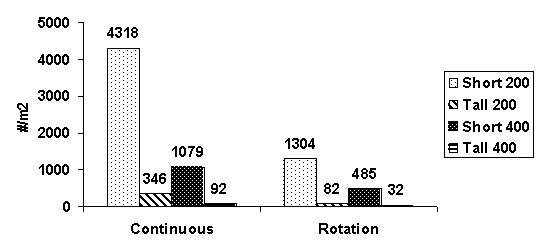| |
Introduction
Considering that we have more weed
management knowledge and alternatives than ever before, it is ironic that
weed control practitioners have tended to narrow the weed management
techniques actually employed. Herbicides are generally over-used and the
rather indiscriminant use of herbicides has led to health and
environmental concerns. The major ecological concern for farmers is the
threat of widespread resistance to herbicides (Beckie et al. 1999).
Another irony is that the most efficacious herbicides usually select for
resistant weed populations most rapidly. Selection for herbicide
resistance only ceases when herbicides are not used.
Integrated
weed management does not preclude herbicide use, it includes their
judicious use along with other agronomic methods that help crops compete
with weeds and reduce weed seed production (Thill et al. 1991). Before
herbicides were widely available, farmers employed cultural measures to
manage weed populations. These methods are still valid and provide
insights for successful weed management systems today. Cultural practices
such as seeding competitive cultivars (Harker et al. 2003b, O’Donovan et
al. 2000), using higher than normal seeding rates (Blackshaw et al. 2004,
Harker et al. 2003b, O’Donovan and Newman 1996, O’Donovan et al. 2000,
O’Donovan et al. 2001), altering normal crop seeding dates (Kirkland and
Johnson 2000), planting crops for silage (Harker et al 2003a) or green
feed to restrict viable weed seed production, and crop rotation (Blackshaw
1994) still have much value (Harker et al. 2001). In the future, we may
also benefit from current research on seed destruction techniques
(rolling, cracking, radiation, etc.) on combines, whole-plant harvesting
and removal of weed seeds from the field, and genetic triggers for
destroying the viability of volunteer seeds ("terminator
genes").
Some results
Cultural practices that improve
crop health often enhance weed management by supporting rapid crop canopy
growth and closure. Figure 1 illustrates that wild oat seed production
(#/m2) at 25% herbicide rates has been dramatically reduced after three
years of practices which optimized crop health and crop canopy. Higher
barley seeding rates coupled with a tall, competitive variety, reduced
wild oat seed production 47-fold in the continuous barley rotation.
However it is notable that wild oat seed production was reduced more than
100-fold if the same treatments were employed in a more healthy rotation
(barley-canola-barley). Restricting weed seed production gives producers
greater opportunities and latitude to practice integrated weed management
(Harker et al. 2003b, Liebman and Davis 2000). It is discouraging, if not
foolish, to attempt to reduce herbicide use following a weed
"explosion".
Greater emphasis on simple practices such as
competitive cultivars and higher seeding rates will help make integrated
weed management practices more effective. The best weed managers will then
determine and employ optimal combinations of these and other cultural
practices for successful integrated weed management on their farm. More
data will be presented at the meeting...

FIGURE
1. Wild oat seed production in barley
at Lacombe, 2003. "Short" and "Tall" barley are 'Peregrine' and 'AC
Bacon', respectively. Seeding rates were either 200 or 400 seeds/m2. The
rotation treatment was barley-canola-barley. LSD (0.05) for all means =
1091.
References
- Beckie, H. J., A. G. Thomas, A. Legere, D. J. Kelner, R.C. Van
Acker, and S. Meers. 1999. Nature, occurrence, and cost of
herbicide-resistant wild oat (Avena fatua) in small-grain
production areas. Weed Technol. 13:612-625.
- Blackshaw, R. E. 1994. Rotation affects downy brome (Bromus
tectorum) in winter wheat (Triticum aestivum). Weed Technol.
8:728-732.
- Blackshaw, R. E., J. R. Moyer, J. T. O’Donovan, K. N. Harker, and G.
W. Clayton. 2004. Alternative weed control options. Proc. Alberta
Agronomy Update, Jan. 13-14, Red Deer, Alberta.
- Harker, K. N., G. W. Clayton, T. K. Turkington, J. T. O’Donovan, R.
E. Blackshaw, and P. Thomas. 2001. How to implement IWM in canola.
In R. E. Blackshaw and L. M. Hall, eds. Integrated Weed
Management: Explore the Potential. Sainte-Anne-de-Bellevue, Quebec, H9X
3R9. pp. 91-98.
- Harker, K.N., Kirkland, K.J., Baron, V.S., and Clayton, G.W. 2003a.
Early-harvest barley (Hordeum vulgare) silage reduces wild oat
(Avena fatua) densities under zero tillage. Weed Technol.
17:102-110.
- Harker, K.N., Clayton, G.W., Blackshaw, R.E., O’Donovan, J.T., and
Stevenson, F.C. 2003b. Seeding rate, herbicide timing and competitive
hybrids contribute to integrated weed management in canola (Brassica
napus). Can. J. Plant Sci. 83:433-440.
- Kirkland, K. J. and E. N. Johnson. 2000. Alternative seeding dates
(fall and April) affect Brassica napus canola yield and quality.
Can. J. Plant Sci. 80:713-719.
- Liebman, M. and A. S. Davis. 2000. Integration of soil, crop and
weed management in low-external-input farming systems. Weed Res.
40:27-47
- O’Donovan, J. T. and J. C. Newman. 1996. Manipulation of canola
(Brassica rapa) plant density and herbicide rate for economical
and sustainable weed management. Proc. 2nd International Weed Control
Congress, Copenhagen, vol. 3:969-974. Published by Dept. of Weed Control
and Pesticide Ecology, Flakkeberg, DK/4200 Slagelse, Denmark.
- O'Donovan, J.T., Harker, K.N., Clayton, G.W and Hall. L.M. 2000.
Wild oat (Avena fatua) interference in barley (Hordeum
vulgare) is influenced by barley variety and seeding rate. Weed
Technol. 14:624-629.
- O'Donovan, J. T., K. N. Harker, G. W. Clayton, J. C. Newman, D.
Robinson, and L. M. Hall. 2001. Barley seeding rate influences the
effects of variable herbicide rates on wild oat (Avena fatua).
Weed Sci. 49:746-754.
- Thill, D. C., J. M. Lish, R. H. Callihan, and E. J. Bechinski. 1991.
Integrated weed management – a component of integrated pest management:
a critical review. Weed Technol. 5:648-656
K. N.
Harker1, G. W.
Clayton1, J. T.
O’Donovan2, and R.E.
Blackshaw3
1Agriculture and Agri-Food
Canada, 6000 C&E Trail, Lacombe, AB T4L 1W1
2Agriculture and Agri-Food Canada, Box
29, Beaverlodge, AB T0H 0C0
3Agriculture and Agri-Food Canada, Box
3000, Lethbridge, AB T1J 4B1 |
|